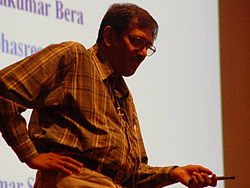Debashis Mukherjee
| Debashis Mukherjee | |
|---|---|

At the 12th ICQC in Kyoto, 2006
|
|
| Born |
17 December 1946 Naihati, West Bengal |
| Residence | India |
| Nationality | Indian |
| Fields | Chemistry, theoretical chemistry |
| Institutions | Indian Association for the Cultivation of Science |
| Alma mater | Presidency College, Kolkata, University of Calcutta |
| Known for | Multireference Coupled Cluster Theories |
Debashis Mukherjee is a theoretical chemist, well known for his research in the fields of molecular many body theory, theoretical spectroscopy, finite temperature non-perturbative many body theories. Mukherjee has been the first to develop and implement a class of many-body methods for electronic structure which are now standard works in the field. These methods, collectively called multireference coupled cluster formalisms, are versatile and powerful methods for predicting with quantitative accuracy the energetics and cross-sections of a vast range of molecular excitations and ionization. A long-standing problem of guaranteeing proper scaling of energy for many electron wave-functions of arbitrary complexity has also been first resolved by him. He has also been the first to develop a rigorously size-extensive state-specific multi-reference coupled cluster formalism, and its perturbative counterpart which is getting increasingly recognized as a very promising methodological advance. The attractive aspects of Mukherjee's formalisms are compactness and high accuracy. These are now accepted as pioneering and standard works in the field. which has attracted wide international attention. He has also developed a rigorous finite-temperature non-perturbative field theory to study thermodynamics of strongly interacting many body systems, which is now being applied extensively to study dynamics of vibronic coupling at finite temperature.
Mukherjee has coauthored more than 200 papers on various aspects of theoretical chemistry and edited Aspects of Many-Body Effects in Molecules and Extended Systems, Lecture Notes in Chemistry, Vol. 50 (Springer Verlag, 1989) and Applied Many-Body Methods in Spectroscopy and Electronic Structure (Plenum Press, 1992). He research interests cover the multi-reference coupled cluster theories, the general methodology in many-body theories and real- and imaginary-time quantum dynamics.
Mukherjee has been the earliest developer of a class of many-body methods for electronic structure which are now standard and highly acclaimed works in the field. These methods, collectively called multireference coupled cluster (MRCC) formalisms, are versatile and powerful methods for predicting with quantitative accuracy the energetics of a vast range of molecular excitations and ionization. The attractive aspects of the formalisms are size-extensivity, compactness and high accuracy. He also developed a linear response theory based on coupled cluster formalism (CCLRT), which is similar in scope to the SAC-CI and done independently of it. It pioneered the use of a dressed hamiltonian for energy differences, which has since been used by others. A long-standing problem of guaranteeing size-extensive theories starting with arbitrary reference functions has also been first resolved by him which has attracted wide international attention. Many comprehensive papers on these topics have elicited much interest.
...
Wikipedia
